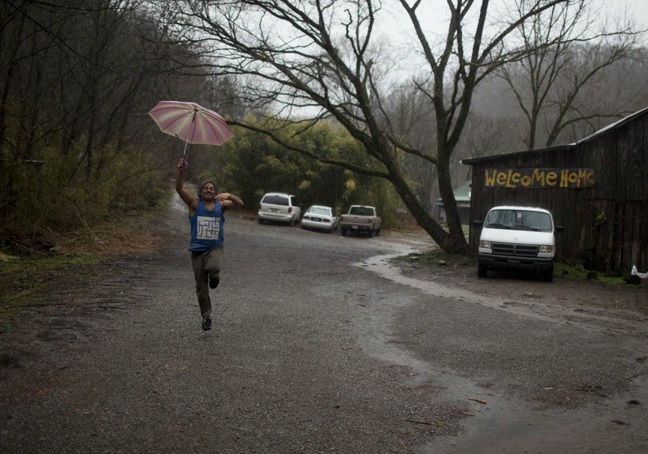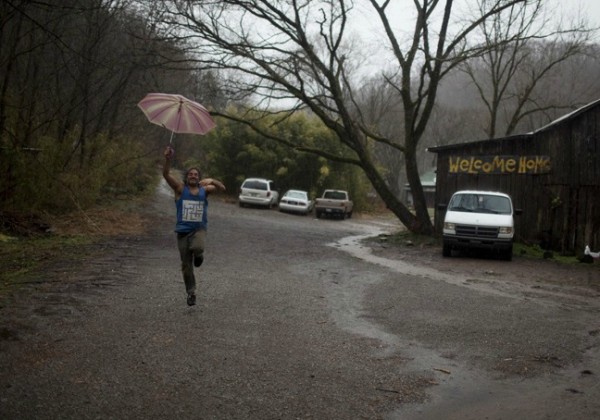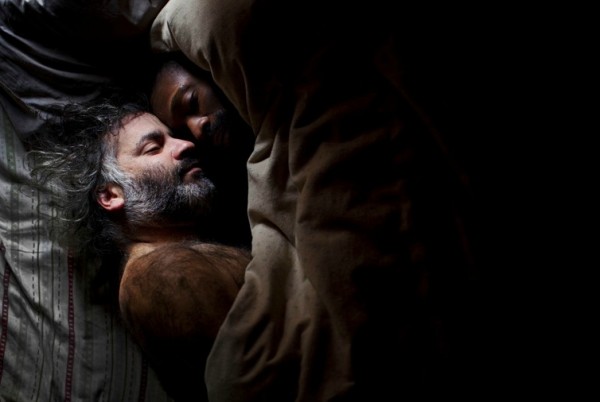EVERYTHING MOVES more slowly now. People sleep more and work less. The weight of winter would continue to press down on us for a few months, but tonight was symbolic. The bitter cold would persist, but from here on out the days would slowly grow longer, minute by minute, until we’d finally shed all these heavy layers and float with the colors of spring.


It was the longest night of the year. The sun had sunk behind the ridge before 4:00, and our evenings had been spent huddled near a wood-fire stove with ten or so others at IDA, eating homemade meals and falling asleep encased in goose down. The Winter solstice was little more than another cold, dark night here. Right over on the mountainside though, the Radical Faeries were preparing a pledge of renewal, remembrance, and rebirth.
“Tonight, we celebrate the reversal of darkness,” shouted Mountaine, slowly pacing back and forth between the crowd and the fire. “And sometimes that darkness outside reflects a darkness within.” It was a time for introspection. An opportunity to examine the year past and set out intentions for the year ahead. We all gathered around a circle of candles to shield the delicate flames from the wind, each of us lighting one and watching it dance. Compassion. Rebirth. Consciousness. Offering that which we most yearned for, we received each other’s intentions in a gentle, warm embrace. Nobody was present for miles to judge or interfere. It was just us and the mountain that night, where cynicism and separateness gave way to empathy and communion in the safety of the Short Mountain Sanctuary.
The place has been running for some thirty years now, one of the very first — some say the first — Radical Faerie sanctuaries in the world. The movement started back in the 70′s, when much of gay culture was expressed in enclaves of major American cities, often typified by the clone — aviator sunglasses wearing, massively muscle-bound, mustache growing, caricatures of masculinity. More mainstream gay movements, on the other hand, were seeking liberation through assimilation and hetero-imitation. But the Faeries had a radically different agenda.
“Faeries would go to gay pride and the gay men would just be horrified,” remembers Phil. “They didn’t want to be associated in any way with these people who were so wacky looking and cross-dressed. They wanted gay people to be perceived the same as the straight community. There was a conscious effort by the Faeries to shove it down mainstream gays’ throats that being gay isn’t like being straight except for being with other men. It is inherently different. And it’s really cool and really fun.”
The Faeries reclaimed the homophobic slur ‘fairy,’ changing its spelling to reflect the spiritualism of mythical faeries and embracing qualities the mainstream culture stigmatized as feminine. For the Faeries, the role of homosexual men in society was largely spiritual, as in some Native American cultures where homosexual and transgendered people often became spiritual mediators and medicine people. They were thought to have an insight into life that others could not attain.
“If you’re born with a different sexual identity than the mainstream is comfortable with,” reasons Phil, “you’re already at an advantage. You have to create who you are to discover who you are. You’re just set up from birth to have to figure out and deal with things that a lot of people don’t even know are questions in life.”
By the early 90′s, the amount of people interested in Short Mountain became too much to handle, and there was a decided need for more space. After considering land around the country, Phil and a few other Faeries settled on over 200 acres in a hollow just miles away from Short Mountain. An artist himself, Phil hoped to cultivate a space with spirituality and art as its pillars. So began IDA — an intentional community of artists with Faerie underpinnings. But it slowly transformed into something that nobody anticipated.
MaxZine met us in Smithville on his bike to take us in. Sometimes described as the mother at IDA, he takes on a whole host of responsibilities to nurture the space and make visitors feel welcome. After helping him adjust his brakes, we cut back through old country roads, cycling past baptist churches and farms before finally rambling deep into IDA’s hollow.
The words “Welcome Homo” greeted us, splayed across the front of a deteriorating barn full of old clothes, bicycles, and a stage for performances. MaxZine showed us around the property, from the houses being built and the solar showers to the spring catchment system and grassy fields where hundreds of people camp during Idapalooza, IDA’s annual music festival.
“There’s been so many pivotal moments in IDA’s history that have helped to change the identity of the community,” explains MaxZine. “One of the visions that started to change early was the desire for IDA not to be a gay male space only. It started as a group of eight men in the woods. Then it became a gender free-for-all.”
When fleshing out a culture and common direction, the IDA residents had a party where everyone came dressed as their vision of IDA in the year 2020. Two of the few women involved in the space still hadn’t shown up when the party was well under way.
“They finally came up the stairs of the barn,” remembers MaxZine. “They had taken their shirts off, topless, and had painted women’s signs on their chests. ‘Here we’re dressed as our vision of IDA!’ It felt like already in our second year the gender and identity of IDA was beginning to change.”
IDA now identifies as a queer space. The concepts of gay and lesbian seem fairly straight forward, but when asking people here about queer, we’d get scrunched eyes, long pauses, and constant equivocation. Everyone has their own notions. And it seems that’s just the point. Queer exalts ambiguity and contradiction, asserting that the boundaries placed on our bodies and minds aren’t real; they can be lifted just as easily as they were put down to begin with.
“Queer…” Phil trails off, searching for the right words. “I see it as primarily a cultural expression that is very fluid, open, and accepting of variation. Being uniquely yourself. It’s not only that queer people are different from straight people, but every person is different and all that difference needs to be celebrated.”
Around IDA, there are plenty of people with Adam’s apples and breasts or with facial hair and makeup. Female carpenters and male bakers, feminine lesbians and androgynous transgendered people, it all melts into a beautifully nuanced fluidity. Few of us ever have the chance to see sex and gender deconstructed right before our eyes, to watch ourselves come to expect a fluid genderscape in our day to day life. Men and women and everyone in between and beyond quickly become just people. Words like gay and bi and straight become blurry approximations — flags that some of us fly over our heads, but not the kind of thing that keeps us on separate fronts. It’s more than just a change in language. It’s queering your thought process — breaking down the biases and binaries between our senses and our brain.
Prejudices and fears about what people are allowed to be are so deeply woven into the larger culture that it’s next to impossible for many of us to fully discover who we are. This was perhaps the most powerful truth that led to the birth of IDA. Often described as a queer safe space, IDA gives people room to express the repressed, to finally learn what it means to be themselves. But safety can be elusive.
“I don’t think that I would call anywhere a safe space,” reasons Cassidy. “Especially a place where people are encouraged to open up and communicate.” She chuckles, her laugh swallowing her face whole. “It’s not really a safe process. People have to learn how to both make themselves feel as safe as possible and also not to intrude and pressure other people. Encouraging a culture of individual responsibility.”
Rejeuvenating in the sauna at Short Mountain after a pot luck one night, one of the men, after learning that Tim and I were brothers and not lovers, asked if we were both gay. A few surprised heads whipped over at our answer. “Oh really?” he trailed off. “Well, you’re welcome here anyway!”
This was the prevailing attitude we encountered — we were mostly taken as people, judged by our people qualities. As long as we were respectful, inspired, and curious, we had little trouble making friends and feeling welcome in the community. But word got around quickly that we didn’t identify as queer, and some people didn’t take too well to the idea. One person who was incredibly warm to us at the beginning of our stay became increasingly cold and distant. A week later while we cooking up some eggs, they approached us. “So…I had a question about y’all’s film.” Their eyes darted between ours and the table.
They were uncomfortable with the idea of two straight people representing a queer space, and for that matter about foreign representation in general. This echoed through my own sensibilities, so I had to pause to gather my thoughts. I cringe every time I open a magazine, only to see a culture’s wisdom and ancient traditions reduced to a few photos of dirty skinny brown people. We take our prejudices with us wherever we go and in whatever capacity we work. Were we the kind of people they came out to the woods to get away from in the first place?
There was already sensitivity and resistance to us making a film about the community. Some people were afraid of exposure. After all, rural Tennessee is an unlikely place for this kind of thing to be happening, and it sometimes can feel fragile. Some were afraid of hate crimes, and others just didn’t want extra publicity — plenty of people already participated in IDA, and too much exposure could overcrowd the place. And now there was the added anxiety of us maybe not being queer enough to represent the place at all.
Despite the conflicted tensions, the community welcomed us for the duration of the project, inviting us into their home and offering themselves as subjects for months. Finally showing the finished film felt like a heavy sigh of relief. We were graciously approached by the person who most vocally opposed our presence. To his surprise, he found the film beautiful. Our project had helped him consider a lot of his prejudices and concepts of personal identity. It had done the same for us. It may be connections like this that are slowly making cracks in that already fragile, final binary between queer and straight.
In some ways it was frustrating to be pegged so unequivocally as ‘straight’ by some people here, not given a chance to explore our own nuances in the way the space was created for. Only after leaving did we begin to fully respect the resistance and skepticism we encountered. We came in too lightly. Despite our eager enthusiasm for the malleable concept of queer, we’re not capable of fully understanding queer space — not on the level that people here do. I’ve never felt the confusion and isolation of being assigned a gender that wasn’t my own. Or feared for my life walking down the street at night, hand locked with a lover’s. No family member has ever disowned me. The only time I’ve really felt othered and ostracized due to my gender and sexuality is here. And maybe that’s exactly what I needed to learn.
Noah and Tim are creating a documentary called America Recycled. They are in the midst of a fundraising campaign in which all donations will be matched dollar for dollar, a prize for winning the USA Creative Vision Award. Fundraising ends April 7, 2013. To see this film completed, please donate at USA Projects.
* This post was published in its original form here.



